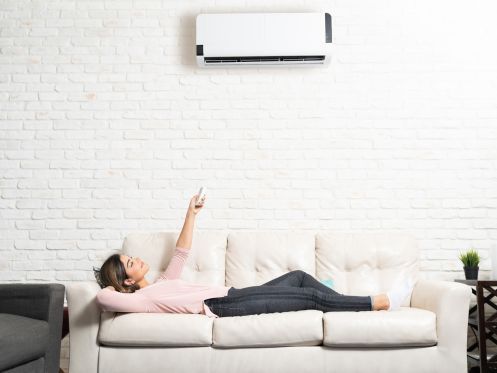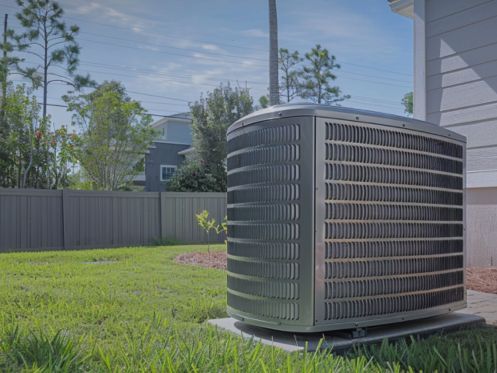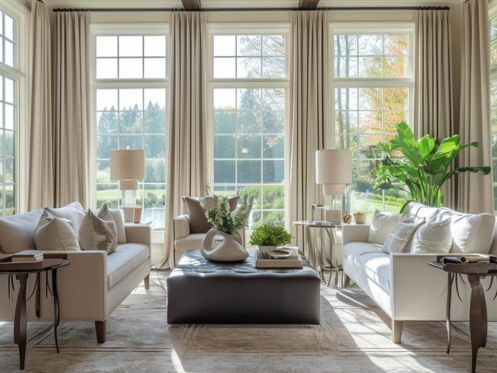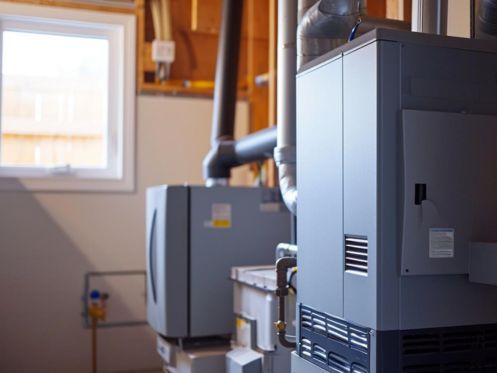Illuminating Air Quality: Why UV Light is a Game-Changer for HVAC Systems

Table of Contents
Ultraviolet (UV) Light has been used in HVAC systems for decades, now; however, advances in technology have realized more effective applications. This article will explain the science behind UV light in HVAC systems; outline the key benefits of integrating UV light into HVAC; explain safety and maintenance of UV installations in HVAC, and; discuss the future of air quality with innovations in UV technology.
The Science Behind UV Light in HVAC Systems
The use of ultra-violet (UV) light in HVAC systems is becoming increasingly popular in many home and industrial applications. This is due to the many benefits that can be derived from its installation. UV light is a type of radiation that falls within the electromagnetic spectrum and is invisible to the naked human eye. UV light is commonly used in the air conditioning systems of homes, businesses, and other facilities for its ability to reduce the presence of certain bacteria or microbes in the air. However, the proper functioning of UV light in such systems is dependent on an understanding of the science behind it.
The primary working mechanism of UV light lies in its ability to disrupt the DNA within living organisms. This is done by targeting the nuclei in the cells which contain the genetic material, preventing bacteria from multiplying and therefore curtailing their number. This is done through the use of different types of UV light, such as UV-C, UV-A, and UV-B radiation. Each type has a different wavelength, resulting in the disruption of different types of cells and chemicals, which in turn results in a purification of the air circulating through the HVAC system.
In addition, the type, intensity, and duration of the UV light which is used can be greatly varied so as to produce a desired result. For instance, UV-C radiation is generally used to address microbial contamination, while UV-A is meant for treating volatile organic compounds (VOCs) and odors. Furthermore, the exposure time of the UV light may also be adjusted to maximize its efficacy in eliminating certain compounds present in the air circulating within an HVAC system.
One important factor to consider when using UV light is the need to protect individuals from overexposure to ultraviolet radiation. Overexposure to UV radiation can cause skin and eye irritation, as well as damage to the DNA of living organisms. Therefore, safety measures must be taken to limit the amount of UV radiation to which humans may be exposed. Such precautions may include installation of lights in areas of the HVAC system which are not frequently accessed, as well as the use of filters or UV-blocking screens to limit radiation levels within the system.
In summary, the use of UV light in HVAC systems offers many benefits in the reduction of airborne bacteria and contaminants. However, a proper understanding of the science behind UV light is required to maximize its potential and to ensure the safety of those who may be exposed to it. Thus, proper installation and maintenance of UV light in an HVAC system are necessary to ensure the continued reduction of airborne contaminants while minimizing the risk of overexposure to UV radiation.
Key Benefits of Integrating UV Light into HVAC
Integrating UV light into a HVAC system can bring multiple benefits. One major benefit is improved indoor air quality. UV light can reduce potentially harmful airborne microorganisms, allergens, and mold spores that could otherwise lead to health issues for the occupants. UV lights also have the potential to reduce pollutants such as volatile organic compounds (VOCs) that are re-released from furniture, carpets, and paints. Furthermore, UV light can be applied to reduce odors coming from drainage or other sources.
However, UV light integration also provides benefits beyond air quality improvements. UV light that’s integrated in a HVAC system also helps to increase the efficiency of the system by killing bacteria, fungi, and other contaminants on the surfaces of cooling coils and duct linings, reducing the need for routine duct and air filter cleaning. Additionally, UV light can reduce the amount of energy consumption of the HVAC system, since it can replace chemical treatments and filtration and avoid the additional energy usage and cost associated with keeping them operational.
In addition, integrating UV light into a HVAC system also helps make it easier for facility managers to keep building temperature and humidity levels under desired control. The UV light will kill any microorganisms that would otherwise create excessive condensation on surfaces. As a result, the increased ventilation capacity from the lower humidity will allow the HVAC system to cool quicker and easier, creating a detectable improvement in the overall building temperature.
Consequently, adding UV light into a HVAC system provides numerous key benefits pertaining to both air quality and cost efficiency. It also helps improve building temperatures and reduce unwanted humidity levels. Facility managers and property owners who choose to include UV light into their HVAC systems can generally expect to see long-term improvements to their building environment and energy efficiency.
Safety and Maintenance of UV Installations in HVAC
UV installations in HVAC systems, also known as ultraviolet lights, are important components for efficient indoor air quality. They help keep rooms and other spaces clean and safe for occupancy by killing germs and harmful biological particles. However, they require safety measures and consistent maintenance to ensure proper functioning and good results.
The most important maintenance step is to replace the UV bulbs regularly. They should be replaced at least once a year, depending on the frequency of use and the age of the bulbs. Moreover, the bulbs should be checked periodically for quality and effectiveness, to make sure they are still working properly. Make sure to keep the UV bulb away from direct contact with other surfaces, as this can reduce its lifespan and effectiveness. In addition, to avoid electrical shocks or overheating, users should make sure to disconnect the power source before tending to the bulbs.
The internal wiring of the fixtures must also be checked, as well as the aging of insulation material or wires. Furthermore, the distance between the lamp and the reflective surface should be adjusted according to the size of installation being used. Similarly, it is important to keep the regular cleaning and inspection of the reflective surfaces of the ultraviolet lighting system to make sure that no dust and other debris accumulates, as this can decrease its effectiveness.
Regular inspection of filters and other parts is also necessary for efficient performance and cleaning of the air. Consequently, all parts should be tested and inspected before each use to avoid malfunctions or excessive wear. Finally, it is important to follow the manufacturer’s safety instructions and procedures to guarantee proper functioning, prevention of microorganisms, and occupant safety.
In conclusion, while UV installations are important components for the efficiency of HVAC systems, proper safety and maintenance should be observed to ensure proper functioning and optimal air quality.
The Future of Air Quality: Innovations in UV Technology
The quality of air has been a growing concern in recent years, resulting in some substantial technological developments in the field. One such development has been the use of UV technology to help reduce some of the dangerous elements in the air. However, this technology is still relatively new, and its future implications for air quality remain largely unexplored.
Innovations in UV technology are beginning to show promising results when it comes to improving air quality. Specifically, ultraviolet light has been found to be effective in breaking down various pollutants, such as nitrogen dioxide, sulfur dioxide, and formaldehyde. Moreover, the technology has also been used to kill bacteria from the air. The efficacy of UV has been demonstrated in numerous laboratory studies, as well as in some real-world applications.
On the other hand, UV technology has some important limitations that need to be addressed and improved upon in the future. For instance, while UV light is proven to reduce numerous air pollutants, it is not as effective in reducing the amount of particulate matter and other hazardous airborne materials. Additionally, its ability to reduce bacteria in the air is limited by the amount of time the light is exposed to the air and the intensity of the light itself.
In addition to its limitations, the use of UV technology is still limited by cost. Currently, the implementation of UV technology is fairly expensive, and not many organizations or individuals have the resources to install systems. Furthermore, the maintenance of these systems can be costly as well, due to the need for frequent replacement of bulbs.
Therefore, in order for UV technology to be more widely accepted and utilized, both the cost and efficiency of the technology must be addressed. Additionally, the research on the long-term impacts of UV technology in both the indoor and outdoor environments should be further investigated. If these efforts can be successful, then UV technology could potentially become a more viable solution for air quality improvements, making it a more sustainable option for the future.
In contrast, if the current limitations of UV technology remain, then other alternatives for achieving better air quality may need to be sought. Similarly, greater emphasis will need to be put on educating others on the importance of maintaining clean air. As a result, more stringent measures may be necessary to promote better air quality.
Consequently, there is still much work to be done in order to ensure better air quality in the future. Innovations in UV technology will undoubtedly be a cornerstone in this effort, if done properly. With the right investment of time and resources, this technology may have the potential to revolutionize the air quality industry.
Key Takeaways
It is clear that the use of ultraviolet light in HVAC systems can provide multiple benefits, including improved air quality and increased system efficiency. Ultraviolet light technology has been proven to be able to eliminate biological contaminants from air, and when used as part of an overall HVAC system, it can help reduce energy consumption, improve occupant comfort, and help to reduce the spread of airborne disease. For in-home systems, safety features such as automatic shutoff when the lamps reach the end of their useful life, along with routine cleaning and maintenance, are essential to ensure proper operation and prevent potential hazards. Lastly, the use of newer UV technology such as UV-C LEDs and mobile UV disinfection systems promise to revolutionize the air quality industry, and are likely to be the wave of the future.
Frequently Asked Questions
What is the primary function of UV light in HVAC systems?
The primary function of UV light in HVAC systems is to reduce or eliminate the levels of airborne mold, bacteria, and other harmful contaminants. This is achieved by exposing these particles to germicidal UV light, which destroys their cellular structure, rendering them unable to reproduce and spread.
Is it safe to have UV light in my HVAC system?
Yes, it is safe to have UV light in your HVAC system. UV lights have been proven to help eliminate the growth of mold, mildew, and other airborne pollutants that can reduce air quality. Many HVAC systems now come with pre-installed UV lights, but care must be taken to keep the light at a safe distance from people and animals. Additionally, regular maintenance and replacement of the bulb is important for proper functioning.
How often should the UV bulbs be replaced in an HVAC system?
UV bulbs in an HVAC system should typically be replaced every 12 months to ensure they are running at their peak performance.
Does the addition of UV light increase the energy consumption of my HVAC system?
In most cases, the addition of a UV light will not significantly increase the energy consumption of an HVAC system. Some minimal additional energy consumption may be necessary to power the UV lamp, but the efficiency gains from better air quality and reduced maintenance often outweigh the additional energy requirement.
Other Blogs You May Be Interested In
Categories














Leave a Reply